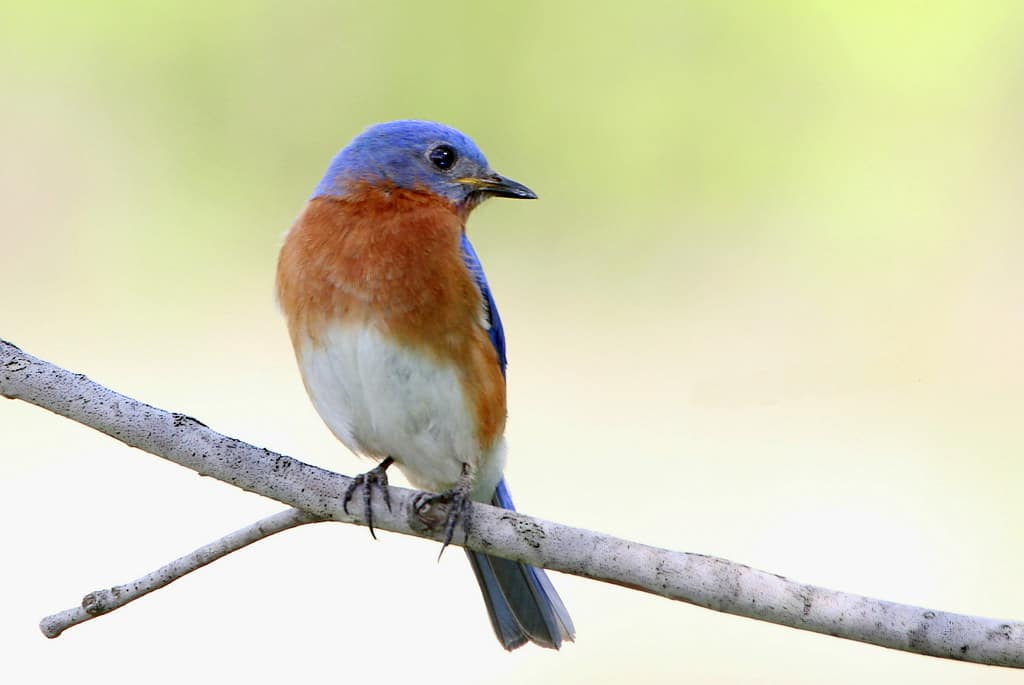
Someone who attracts and cares for bluebirds by providing a safe place for them to nest. This is my definition of a bluebird landlord. A bluebird landlord could be a professional ornithologist who monitors bluebirds on a nature trail, or an average birdwatcher (like me) who attracts bluebirds to their backyard. If you’re one of those average birdwatchers like me and you want to attract bluebirds to your own backyard, you should become a bluebird landlord too!
When deciding to become a bluebird landlord, just know that it will take a little more effort than simply putting up a bird house. It will require some information and know-how to become a successful bluebird landlord, but attracting bluebirds to your yard, year after year, is definitely worth the effort.
So, let’s get started. Here are 10 steps to become a successful bluebird landlord:
- Find out what species of bluebirds live in your area
- Know what to expect from bluebirds throughout the year
- Put up a bluebird house in an ideal location
- Monitor your bluebird houses weekly
- Deter predators and non-native species
- Remove house sparrow nests if you find them
- Enjoy watching your bluebirds
- Feed your bluebirds to supplement their diet
- Remove bluebird nests after the fledglings leave
- Sanitize bluebird houses at the end of the nesting season
Click on any of the steps above to jump ahead to that point of the article.
Step #1. Find out what species of bluebirds live in your area
Bluebirds are a native song bird to North America, and their range spans from Canada to the Caribbean. They are beautiful, shockingly blue songbirds that have even been called “America’s favorite bird.” Many people don’t realize that there are actually three species of bluebirds that inhabit North America – eastern bluebirds, western bluebirds, and mountain bluebirds.
To become a successful bluebird landlord, the first step is to identify which species of bluebirds live in your area. This is important because different species of bluebirds will require different-sized entrance holes on the nest box that you use. Read what I’ve written about proper entrance hole sizes here.
Let’s start with the most common species of bluebird…
Eastern Bluebirds

Eastern bluebirds are usually found east of the Rocky Mountains from Canada all the way south to Mexico and into the Caribbean. Take a look at the range map below to see where you can find them. The yellow and green spots on the map mark their breeding territory and their year-round territory respectively. If you live in the yellow or green zones, it’s likely you can attract eastern bluebirds where you live.

Western Bluebirds

Now, let’s look at western bluebirds. As their name implies, you can find this species of bluebirds west of the Rocky Mountains in the US, Canada, and Mexico. If you live in the yellow or green regions below, keep on the lookout for western bluebirds.

Mountain Bluebirds

As for mountain bluebirds, these beautifully blue and white birds typically reside at higher elevations west of the Rocky Mountains. If you find yourself in the yellow or green regions on the map below, you’re in mountain bluebird territory.

Step #2. Know what to expect from bluebirds throughout the year
The second step in becoming a bluebird landlord is understanding what to expect from bluebirds in the different seasons of the year. Bluebirds go through a nesting season in the spring/summer, and an off season in the fall/winter, so you can expect slightly different behavior from your bluebirds during these two periods of time.
Here’s what to expect from bluebirds during the nesting and breeding season.
Bluebird activity during the spring and summer

Bluebirds generally start scouting out a nesting site in February or March, and hopefully they will pick your nest box! Since they can start scouting so early, I usually recommend having your nest box set up and ready to go by mid February. You can read more about why I choose to set up my bluebird houses in February here.
After you set up your nest box, it’s all about attracting bluebirds and monitoring them for the rest of the spring and summer. The most helpful piece of information I learned as a new bluebird landlord was how long bluebirds actually incubate their eggs before they hatch. This info comes in handy when you’re impatiently waiting and waiting for them to just hatch already!

Photo by Robert Pruner is licensed under CC BY-NC-ND 2.0
Just so you know this helpful piece of information as well, the female eastern bluebird will incubate her eggs for around two weeks and the babies will remain in the nest for another three weeks after hatching.
Check out this great article from Sialis.org that shows you exactly what to expect from a pair of bluebirds from the time they build a nest until their young birds finally fledge. This kind of information will help you keep your sanity during the nesting season if you’re an impatient person like me.
Now, here’s what to expect during the “off” season, when bluebirds are not busy breeding and nesting.
Bluebird activity during the fall and winter
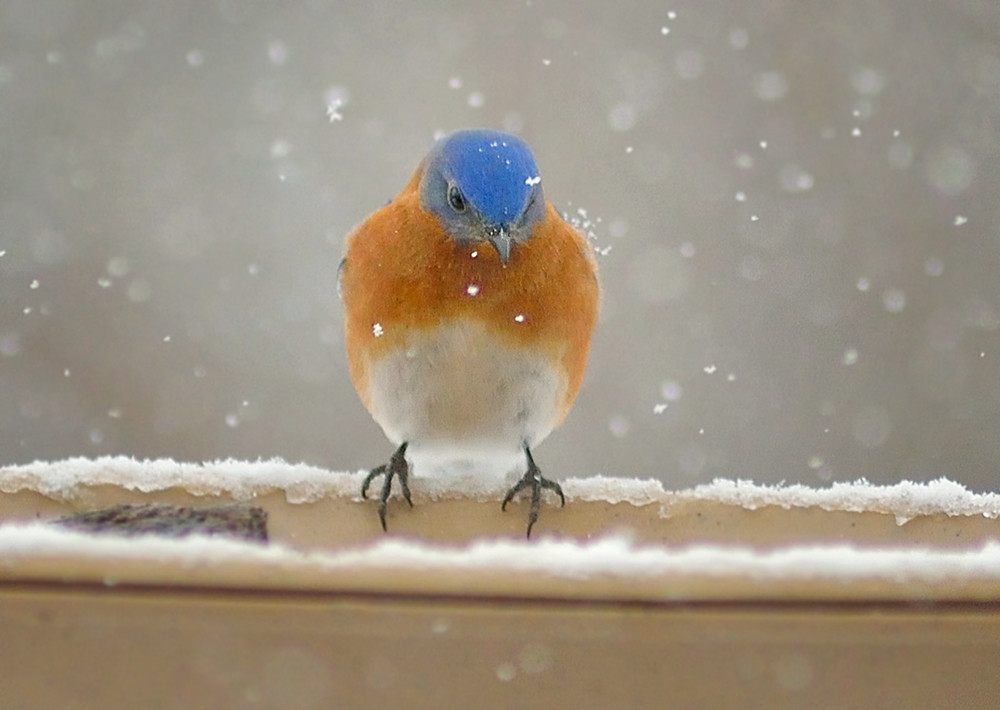
Luckily, unless you’re farther north in the US or Canada, bluebirds tend to stick around all winter long. So, depending on where you live, you may get the chance to see these wonderful birds year-round!
While bluebirds won’t need a place to nest during the late fall and winter, you can help them out by providing them some additional food, since insects will start to become scarce during this time. You won’t attract bluebirds to your feeder with generic bird seed that you might buy at the hardware store, but there are plenty of foods that bluebirds will go for. Dried fruit, live mealworms, and peanut butter are all great feeder options that will keep bluebirds happy in the winter. Click here to read my article about what (and how) to feed bluebirds in the winter.
Step #3. Put up a bluebird house in an ideal location
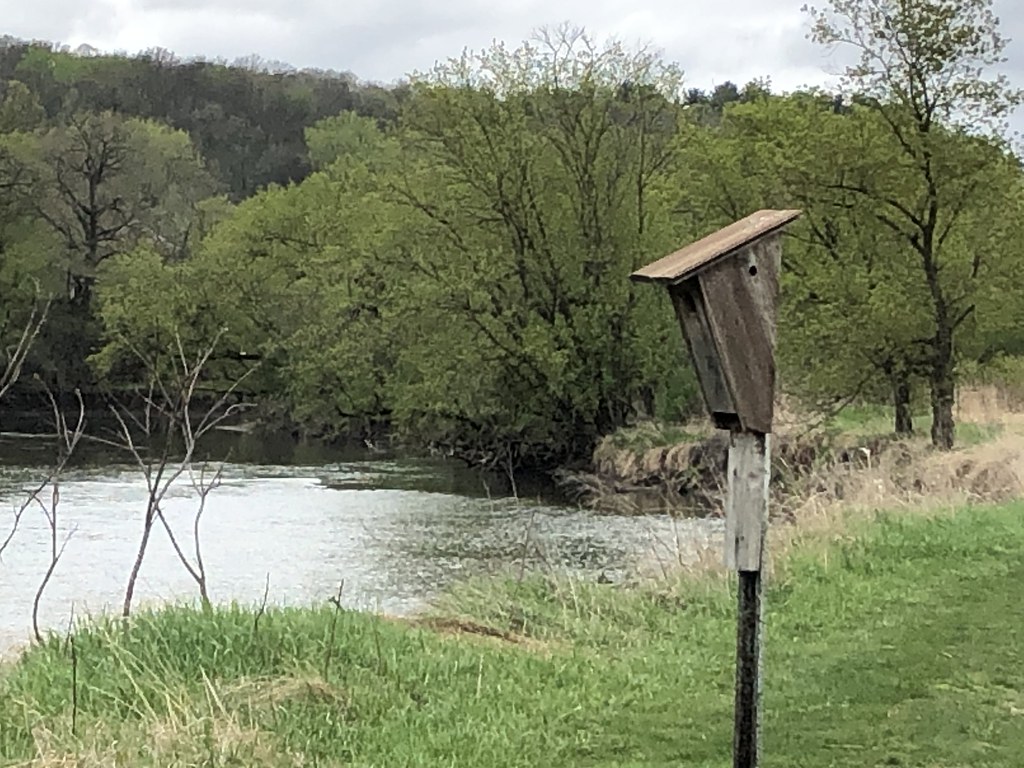
When putting up a bluebird house (nest box) for the first time, you’ll want to think about the ideal spot for your nest box before you make a permanent decision. To make a good decision, let’s consider the habitat that bluebirds thrive in.
Generally, bluebirds love open fields and lawns where they can catch insects, especially places with low perches like fence posts or small trees where they can sit and hunt for bugs. This is why bluebirds thrive in places like cemeteries and golf courses – these both have plenty of open hunting space, short lawns, and abundant low perches.
So, when deciding where to mount a bluebird house in your own yard, consider a sunny, open area with access to low perches that bluebirds can use for hunting. Fence posts and small trees work perfectly as perches. If you have these in your yard, even better. Avoid mounting your nest box too close to your house (house sparrows might compete for a spot like this), and keep the nest box at least 50 feet away from heavily-wooded or brushy areas (this is house wren territory).
Looking to purchase a bluebird house? Check out my Recommended Tools page here to see the nest boxes that I use and recommend.
If you mount your bluebird house in an ideal location, like the one suggested above, you’ll be setting your bluebirds up for success right out of the gate. Then, when the nesting season begins, you’ll be ready for step number four.
Step #4. Monitor your bluebird houses weekly

Photo by USFWS Mountain Prairie is marked with CC PDM 1.0
Checking on your nest boxes regularly will provide you with invaluable information. It will let you know if predators, like snakes and raccoons, are threatening your bluebirds. More commonly, it will help you keep non-native competitors, like house sparrows, at bay.
That’s why it’s best to monitor your bluebird houses at least once a week during the nesting season.
If you go more than a week without checking on your nest box, you’ll give house sparrows a chance to build a full nest and stake a claim of the territory. However, if you check your nest box frequently, you’ll be more likely to catch predators trying to access the box, and more likely to deter non-native birds before they become too much of a hassle.
That brings me to step number five of becoming a bluebird landlord – deterring predators and non-native species.
Step #5. Deter predators and non-native species
This is the least fun part of attracting and caring for bluebirds – dealing with predators and non-native species. But since predation is one of the main causes for bluebirds abandoning their eggs (which I explain more about in this article), deterring predators and non-native birds is an essential way to care for your bluebirds and keep them coming back to you year after year.
Let’s take a look at a few predators your bluebirds might face in the natural environment of your backyard.
Common backyard bluebird predators
The top three predators that you’ll need to look out for as a bluebird landlord are cats, snakes, and raccoons. Let’s look at these natural predators one at a time and consider the best ways to deter them.
Cats

Mounting your nest box away from your house and/or tall bushes will go a long way in keeping cats from disturbing the nest box. Setting up the box on a metal pole and including a predator guard on the nest box will help as well.
Notice the predator guard over the entrance hole in the picture above limits how far the cat can reach into the nest box. The same Nature’s Way bluebird nest box that I use actually comes with a pre-fitted predator guard. You can view and purchase this nest box on Amazon here.
Avoid mounting your bluebird nest box on a wooden post or nailing it too a tree, since these spots are easy for predators to climb.
While cats are a simpler predator to deter, climbing animals like raccoons and snakes are a little bit trickier to deal with.
Snakes and Raccoons
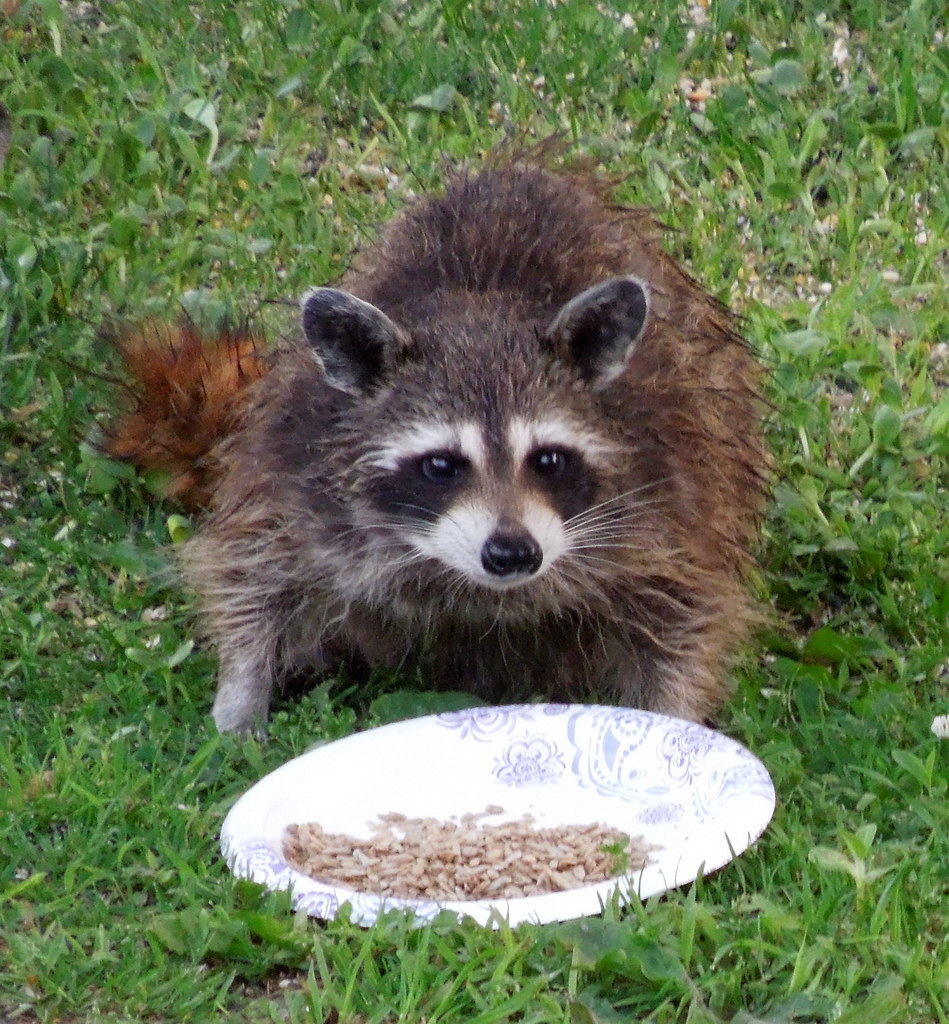
Snakes and raccoons will both try to enter nest boxes to consume bluebird eggs and/or nestlings. If you notice snakes or raccoons climbing the metal pole to your bluebird house, it’s time to install a stovepipe-style baffle under your nest box.
A stovepipe baffle is a deterrent that attaches to the metal pole of your nest box. When installed correctly it will keep raccoons and snakes from climbing the pole and accessing the bluebird house. Check my Recommended Tools page to see the stovepipe-style baffle that I recommend.
Now, let’s consider some non-native birds are generally harmful to bluebirds.
Non-native species that compete with bluebirds
The two main non-native birds that compete with bluebirds for nesting sites are European starlings and house sparrows. Let’s look at these two birds one at a time and consider what it takes to keep each of them away from your bluebirds.
European Starlings

European starlings compete heavily with bluebirds for natural cavity nesting sites and food in the winter. But, since starlings are significantly bigger than bluebirds, all you need to do to deter them is use a nest box with a properly-sized entrance hole.
Luckily, a properly-sized entrance hole alone will keep starlings at bay. Check out this article that I wrote to learn every thing you need to know about correct entrance hole sizes for bluebirds.
House Sparrows

While starlings can be deterred by the entrance hole size alone, house sparrows require a more involved strategy.
When dealing with house sparrows, consider the following two proactive methods for keeping them away from your bluebird houses:
- Mount your nest boxes in an open area, away from houses and barns
- Use a nest box designed for bluebirds (no perch or decorative roof)
These two steps will go a long way in providing an attractive place for bluebirds that is less than ideal for sparrows. See the exact bluebird nest boxes that I use on my Recommended Tools page.
Also, if you find that house sparrows are starting to use your bluebird houses, follow these three reactive methods for deterring house sparrows:
- Remove house sparrow nests as soon as you find them
- Install a sparrow-spooker on a nest box after bluebirds have laid their first egg
- Trap sparrows using a Van Ert-style trap if they become a persistent problem
You can also view my Recommended Tools page for links to buy sparrow-spookers and Van Ert-style sparrow traps.
Deterring house sparrows is such an important step in being a successful bluebird landlord that it deserves two spots on this list. That brings me to step number six.
Step #6. Remove house sparrow nests if you find them

This step technically falls under step number five, since removing house sparrow nests is a part of deterring non-native species, but it’s a step that needs repeating! You must remove house sparrow nests if you find them in your bluebird houses. I repeat: do not let house sparrows nest in your bluebird houses.
House sparrows are a non-native bird in North America and they are competitive and extremely aggressive toward bluebirds. They will smash bluebird eggs, kill adult bluebirds, and destroy their young, seemingly with no reason at all. Even if they are not in direct competition for a nest box, house sparrows can be destructive to bluebirds.
Many times, their aggression toward bluebirds seems undeserved and pointless, which is why bluebird landlords take great strides to not let house sparrows nest in bluebird houses. Given that house sparrows can build nests almost anywhere, there’s little reason that they should be given the luxury of a bluebird nest box anyway, especially with the harm they do to the bluebird population.
So, whenever you find a house sparrow nest in your bluebird house, remove it. Take the nest to a compost pile or similar area to dispose of it, since throwing nests on the ground near nest boxes can attract unwanted predators.
Can I legally remove a house sparrow nest with eggs in it?

Since house sparrows are an unprotected, non-native species in North America, you can legally remove their nests, even if the nests contain eggs. This is true in the US as well as in Canada. House sparrows are not protected under the Migratory Bird Treaty Act in the USA (source) or under the Migratory Bird Convention Act in Canada (source).
While it is legal to remove house sparrow nests that contain eggs or young birds, it’s much easier and more humane to remove the nests early before egg laying has begun. This is why weekly monitoring of your nest boxes is so important.
Here’s what a house sparrow nest will look like:
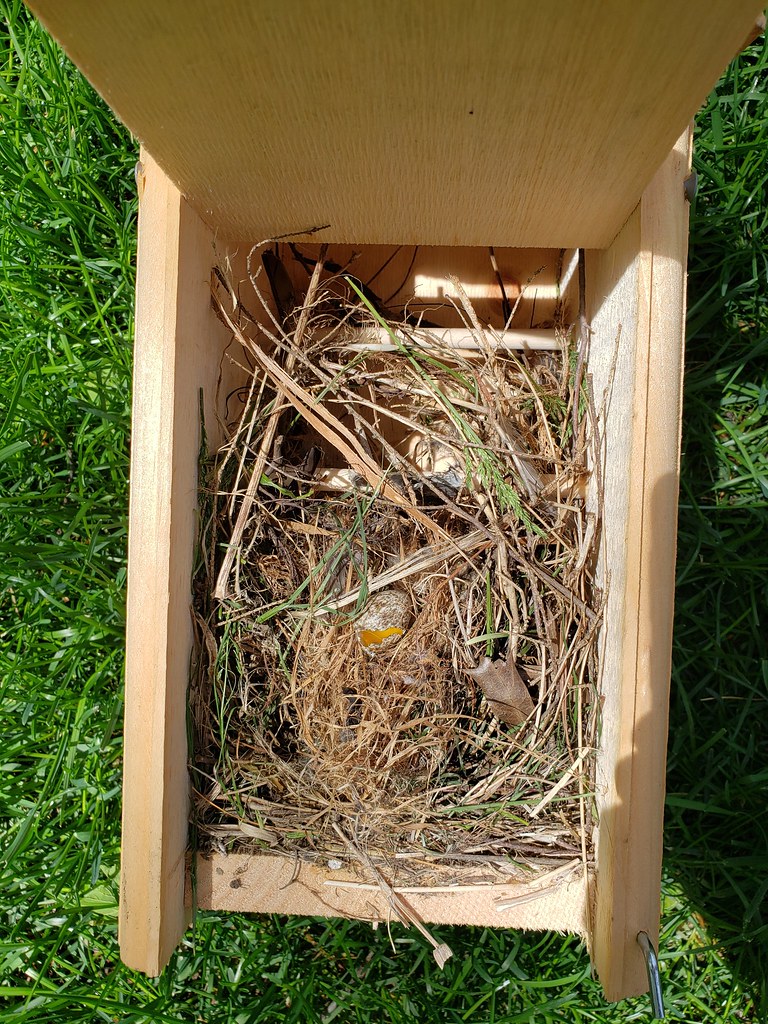
And here’s what a bluebird nest will look like:

House sparrow nests are large messy nests made of grasses, twigs, string, and sometimes bit of garbage thrown in. Generally they aren’t as clean and orderly as bluebird nests. If you find a messy nest of grasses, especially one with brown-speckled eggs, feel free to remove it. To learn a bit more about house sparrow nest and egg identification, check out this article I wrote here.
Now, let’s talk about one of the fun aspects of being a bluebird landlord!
Step #7. Enjoy watching your bluebirds

Step number seven to becoming a bluebird landlord is to just enjoy watching your bluebirds. You probably became interested in attracting bluebirds to your yard either because you love bird watching or you just think bluebirds are really cool. Either way, it’s good to remember why you got into this hobby in the first place.
When you really get into the hobby of being a bluebird landlord, it’s easy to get caught up in the details of deterring house sparrows, monitoring nest boxes, putting up bluebird feeders, etc. But don’t forget why you wanted to become a bluebird landlord in the first place. Remember to actually stop and enjoy watching your bluebirds. They truly are amazing birds.
When is the best time to watch bluebirds?

The best time to watch bluebirds “in action” is right after all of their eggs have hatched and the adults start bringing food back to the nest box to feed their young. At this point, you’ll start to see a lot of activity at your nest box. Both adult bluebirds will become extremely busy feeding their babies, and you’ll likely see them coming to the nest box with an insect in their beak every 10 or 15 minutes. During this time, they’ll be in and out of the nest box, all day long – this is a great time to watch your bluebirds.
If you use a good pair of binoculars, you might even be able to spot the exact insects your bluebirds are feeding their young. In general, I’ve mostly spotted my eastern bluebirds bringing back green caterpillars, spiders, and crickets to the nest. Check out the specific binoculars I use for birdwatching here if you need a good pair.

No matter what you see them bringing back to the nest, the three week feeding frenzy when there are baby birds in the nest is the best time to enjoy watching your bluebirds. So enjoy this period of time. This is what you’ve worked so hard to enjoy.
Step #8. Feed bluebirds to supplement their diet

If you want to go from a good bluebird landlord to a great bluebird landlord, consider putting up a bluebird feeder to supplement your wild bluebirds’ natural diet with extra nutrition. Bluebirds naturally eat mainly insects in the summer, then when winter comes around, they switch to a diet high in fruit to make up for the lost calories from insects. You can follow this natural diet pattern when you are offering extra food to bluebirds throughout the year.
Feeding bluebirds during the spring and summer
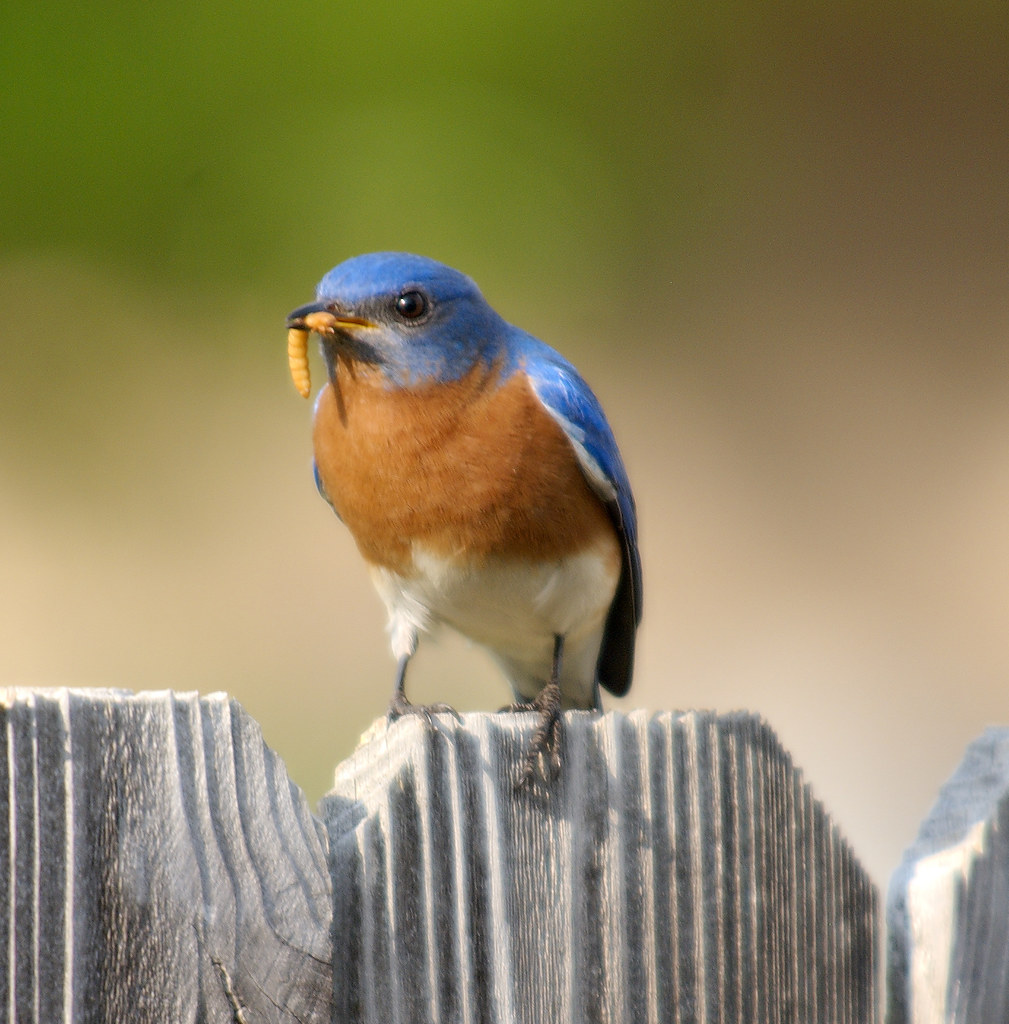
Photo by dbarronoss is licensed under CC BY-NC-ND 2.0
In the summer, when insects are plentiful, bluebirds won’t need much extra food. But, you can entice them to your feeder with live mealworms. Mealworms, a type of beetle larvae, are arguably bluebirds’ favorite type of food to offer at a feeder.
If you’re just getting started with feeding live mealworms to bluebirds, try offering some on a platform feeder that’s set up not too far from your bluebird house. See the platform feeder I recommend on Amazon here.
And if you’ve gotten bluebirds to come to a platform feeder before, consider transitioning to a hanging bluebird feeder like this one (Amazon link). This type of feeder will allow bluebirds to enter but it will keep out larger birds, like starlings and robins.
Check out my Recommended Tools page for the specific feeders that I recommend. On the tools page there’s also a link to where you can buy mealworms in bulk online.
Feeding bluebirds during the fall and winter

When insects become more scarce in the winter, bluebirds usually switch to a fruit-centered diet. You can imitate this pattern by offering your bluebirds fruit and other foods during the colder months. Consider offering your bluebirds dried or fresh fruit, hulled sunflower seeds, and peanut butter during the fall and winter. Click here for a more detailed article I wrote about feeding bluebirds in the winter.
Step #9. Remove bluebird nests after the fledglings leave

One debated topic among bluebird landlords is whether or not you should remove bluebird nests once the fledglings leave. Some people believe that bluebirds want to build their second or third nest of the season in a clean nest box, and others believe that bluebirds prefer to build a new nest on top of an old nest. The debate continues, but there seems to be insufficient evidence to support the idea that bluebirds prefer to build a new nest on top of an old one.
So, in the middle of the nesting season, I recommend that you remove bluebird nests after the fledglings leave, in order to clear out the nest box for future broods.
This is one of the easiest tasks to complete as a bluebird landlord. Once your bluebirds finally fly the coop, which usually happens once the young birds are about three weeks old, just remove the nest and sweep out the nest box. You don’t need to fully sanitize the nest box at this point, just take out the nest and brush off any debris that is left at the bottom of the box. Then remember to dispose of the nest in a different location so you don’t attract predators to the nest box (i.e. don’t just throw the nest on the ground).
This is all you need to do in the middle of the nesting season to turn over the nest box for the next pair of bluebirds.
And this brings me to the final step to becoming a bluebird landlord.
Step #10. Sanitize bluebird houses at the end of the nesting season
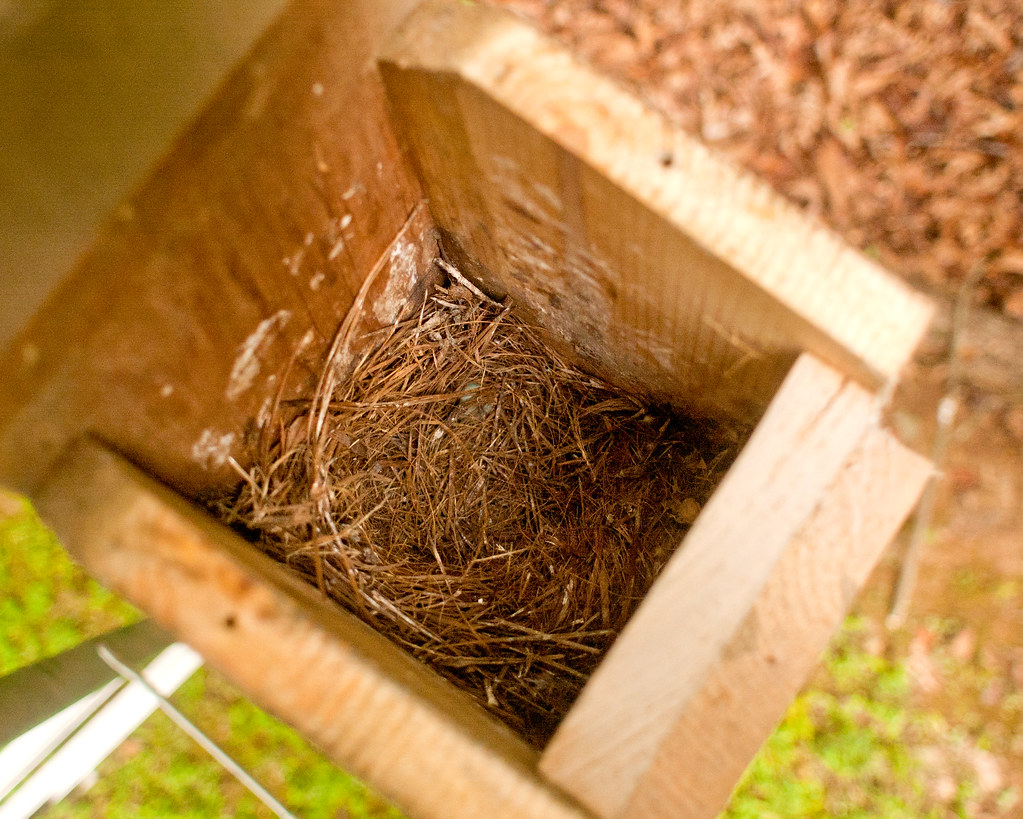
Photo by tommaync is licensed under CC BY-NC-SA 2.0
It is generally considered a good practice to clean out and sanitize bluebird houses at the end of the nesting season. Some prefer to do this in the spring, right before the nesting season starts, instead of in the fall. But, I recommend cleaning out and sanitizing your bluebird houses at the end of the nesting season to avoid parasites and small mammals occupying the nest box over the winter.
Cleaning your nest box at the end of the nesting season doesn’t have to be a huge ordeal. It’s really as simple as throwing out the final nest of the year, sweeping the nest box clear of debris, and washing out the inside of the box with a mild bleach and water solution (source). This should help prevent the nest box from being used by mice or from housing parasites throughout the winter.
At this point of the season, you can choose to either take down your nest boxes or leave them up for the winter. It’s fine to take down your bluebird houses, especially if you’re worried about the winter weather taking its toll on your wooden box, but I suggest keeping the boxes mounted all winter long to provide wintering bluebirds a place to roost.
If you leave your box up during the winter as a roosting spot, consider plugging the ventilation holes to keep cold winds out of the box. Alternatively, if you choose to take your nest box down for the winter, remember to set it back up by February 15th to be ready for the following season (read more here).
Conclusion: What It Takes to Become a Successful Bluebird Landlord
As you can tell, becoming a successful bluebird landlord takes some hard work and know-how. It’s certainly more difficult than just nailing a bird house to a tree in your backyard. But, when you do it the right way, the effort and work you put into this hobby will definitely pay off. Follow these ten steps and you’ll be well on your way to attracting bluebirds to your own backyard.
If you’re still looking for how to begin, building or purchasing a bluebird house is a great place to start. Check out my Recommended Tools page to see the nest boxes that I use, or view my list of DIY nest box plans here.


